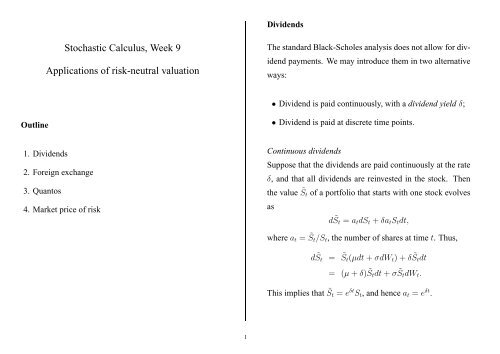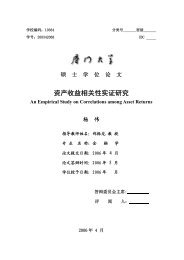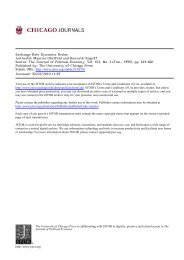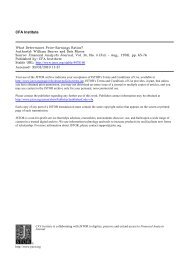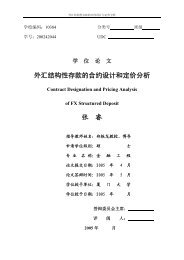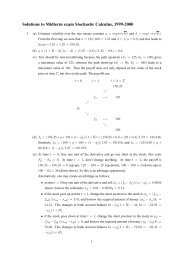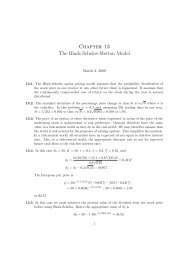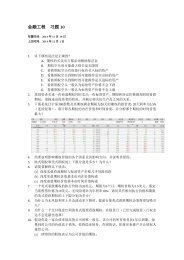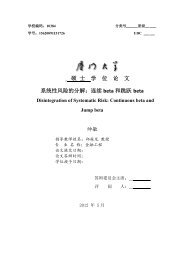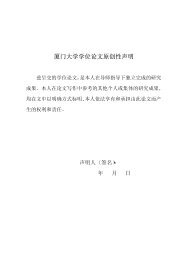Stochastic Calculus, Week 9 Applications of risk-neutral valuation
Stochastic Calculus, Week 9 Applications of risk-neutral valuation
Stochastic Calculus, Week 9 Applications of risk-neutral valuation
You also want an ePaper? Increase the reach of your titles
YUMPU automatically turns print PDFs into web optimized ePapers that Google loves.
Dividends<br />
<strong>Stochastic</strong> <strong>Calculus</strong>, <strong>Week</strong> 9<br />
<strong>Applications</strong> <strong>of</strong> <strong>risk</strong>-<strong>neutral</strong> <strong>valuation</strong><br />
The standard Black-Scholes analysis does not allow for dividend<br />
payments. We may introduce them in two alternative<br />
ways:<br />
• Dividend is paid continuously, with a dividend yield δ;<br />
Outline<br />
• Dividend is paid at discrete time points.<br />
1. Dividends<br />
2. Foreign exchange<br />
3. Quantos<br />
4. Market price <strong>of</strong> <strong>risk</strong><br />
Continuous dividends<br />
Suppose that the dividends are paid continuously at the rate<br />
δ, and that all dividends are reinvested in the stock. Then<br />
the value ˜S t <strong>of</strong> a portfolio that starts with one stock evolves<br />
as<br />
d ˜S t = a t dS t + δa t S t dt,<br />
where a t = ˜S t /S t , the number <strong>of</strong> shares at time t. Thus,<br />
d ˜S t = ˜S t (µdt + σdW t )+δ ˜S t dt<br />
= (µ + δ) ˜S t dt + σ ˜S t dW t .<br />
This implies that ˜S t = e δt S t , and hence a t = e δt .<br />
1
A strategy (φ t ,ψ t ) in terms <strong>of</strong> (S t ,B t ) may be written as<br />
a corresponding strategy (˜φ t ,ψ t ) in terms <strong>of</strong> ( ˜S t ,B t ), with<br />
˜φ t = e −δt φ t . The self-financing restriction now is (with V t =<br />
˜φ t ˜St + ψ t B t )<br />
dV t<br />
= ˜φ t d ˜S t + ψ t dB t<br />
= φ t dS t + φ t δS t dt + ψ t dB t .<br />
The essential point is that, whereas the replicating portfolio<br />
is in terms <strong>of</strong> ˜S t , the derivative is in terms <strong>of</strong> S t . Note that<br />
the measure Q which makes ˜Z t = Bt<br />
−1 ˜S t a martingale, does<br />
not make Bt<br />
−1 S t a martingale.<br />
We find<br />
This yields, via <strong>risk</strong>-<strong>neutral</strong> <strong>valuation</strong>:<br />
• The forward price <strong>of</strong> S t : setting e −r(T −t) E Q [(S T −<br />
F t )|F t ]=0and solving for F t gives<br />
F t = e (r−δ)(T −t) S t .<br />
• The price <strong>of</strong> a call option struck at K. Following the<br />
same steps as in the standard Black-Scholes model, we<br />
find<br />
V t = e −r(T −t) E Q [(S T − K) + |F t ]<br />
= e −δ(T −t) S t Φ( ˜d 1 ) − e −r(T −t) KΦ( ˜d 2 )<br />
= e<br />
{F −r(T −t) t Φ( ˜d 1 ) − KΦ( ˜d<br />
}<br />
2 )<br />
d ˜Z t = (µ + δ − r) ˜Z t dt + σ ˜Z t dW t<br />
= σ ˜Z t d ˜W t ,<br />
where ˜W t = W t + γt, with γ = µ + δ − r , which is a<br />
σ<br />
Brownian motion under the measure Q defined by dQ/dP =<br />
exp(−γW T − 1 2 γ2 T ). Hence<br />
dS t = (r − δ)S t dt + σS t d ˜W t ,<br />
= S 0 exp<br />
([r − δ − 1 2 σ2 ]t + σ ˜W<br />
)<br />
t<br />
S t<br />
with<br />
˜d 1,2 = log(S t/K)+[(r − δ) ± 1 2 σ2 ](T − t)<br />
σ √ T − t<br />
= log(F t/K) ± 1 2 σ2 (T − t)<br />
σ √ .<br />
T − t<br />
2
Discrete dividends<br />
When dividends are paid at discrete time points T 1 ,...,T n ,<br />
then the stock goes ex-dividend, which means its price falls<br />
instantaneously by the amount <strong>of</strong> the dividend. When these<br />
dividends are immediately reinvested, the value ˜S t <strong>of</strong> that<br />
strategy <strong>of</strong> course does not display these discontinuities; i.e.,<br />
we simply may assume<br />
d ˜S t = µ ˜S t dt + σ ˜S t dW t .<br />
(Note: µ here should be compared with µ + δ in the continuous<br />
dividend model).<br />
When the dividend payments are δS t , we obtain<br />
S t =(1− δ) n[t] ˜St ,<br />
where n[t] is the number <strong>of</strong> dividend payments made by<br />
time t.<br />
This implies<br />
F t =(1− δ) n[T ]−n[t] e r(T −t) S t ,<br />
Foreign exchange<br />
Let C t denote the exchange rate, in US dollar per pound<br />
sterling. We’ll assume a geometric Brownian motion for<br />
C t :<br />
dC t = µC t dt + σC t dW t .<br />
Next, consider a US cash bond B t = e rt and a UK cash bond<br />
D t = e ut ; i.e., the interest rates r and u may be different.<br />
From the perspective <strong>of</strong> the US investor, there are two assets:<br />
the domestic cash bond with price B t , and the foreign<br />
cash bond with price S t = C t D t . Note that the latter is a<br />
<strong>risk</strong>y asset; its SDE is<br />
dS t = C t dD t + D t dC t<br />
= (µ + u)S t dt + σS t dW t<br />
= rS t dt + σS t d ˜W t ,<br />
where ˜W t = W t + γt, γ = µ + u − r . This again defines<br />
σ<br />
Q, the <strong>risk</strong>-<strong>neutral</strong> measure.<br />
and the value <strong>of</strong> a call option remains the same in terms <strong>of</strong><br />
F t .<br />
3
Notice that under this measure,<br />
E Q [C T |F t ] = e −uT E Q [S T |F t ]<br />
= e −uT e r(T −t) S t<br />
= e (r−u)(T −t) C t ,<br />
which yields the uncovered interest rate parity:<br />
(r − u)(T − t) = log E Q[C T |F t ]<br />
,<br />
C t<br />
where the right-hand side is the conditionally expected continuous<br />
depreciation.<br />
The forward exchange rate (for delivery at time T ) F t should<br />
solve<br />
e −r(T −t) E Q [(C T − F t )|F t ]=0,<br />
(<br />
and since C T = C t exp [r − u − 1 2 σ2 ](T − t)+σ[ ˜W T − ˜W<br />
)<br />
t ] ,<br />
this will yield<br />
F t = e (r−u)(T −t) C t ,<br />
which gives the covered interest rate parity:<br />
Again, the value <strong>of</strong> a call option on the exchange rate struck<br />
at K is the same as before, when expressed in terms <strong>of</strong> F t .<br />
Change <strong>of</strong> numeraire<br />
The entire analysis could be repeated from the perspective<br />
<strong>of</strong> the UK investor, who has the choice between a sterling<br />
cash bond D t and the sterling value <strong>of</strong> a dollar cash bond,<br />
˜S t = Ct<br />
−1 B t . The discounted price then is Dt<br />
−1 Ct −1 B t =<br />
Z −1<br />
t<br />
, where Z t = Bt<br />
−1 S t . The martingale measure is not<br />
the same as before: a measure which makes Z t a martingale<br />
does not make Zt<br />
−1 a martingale. However, the prices and<br />
hedge ratios are the same, regardless <strong>of</strong> the choice <strong>of</strong> the<br />
measure.<br />
Similarly, in the standard Black-Scholes model we may also<br />
work with a measure Q ∗ which makes St<br />
−1 B t a martingale.<br />
The important thing is to make relative prices martingales –<br />
the choice <strong>of</strong> the numeraire is not important.<br />
(r − u)(T − t) = log F t<br />
C t<br />
.<br />
4
Quantos<br />
Quantos are derivatives which have a pay<strong>of</strong>f in another currency<br />
than the underlying asset, using a fixed, prespecified<br />
exchange rate ¯C (e.g., one dollar per pound sterling). For<br />
example, when S t is a sterling stock price and K is a corrresponding<br />
strike price, then a quanto call has the dollar<br />
pay<strong>of</strong>f<br />
¯C(S T − K) + .<br />
In order to price such a derivative, one has to set up a joint<br />
process for (S t ,C t ), which is a vector diffusion with two<br />
independent Brownian motions (W 1 (t),W 2 (t)):<br />
dS t<br />
= µdt + σ 1 dW 1 (t),<br />
S t<br />
dC t<br />
C t<br />
= νdt + σ 2 dW ∗ 2 (t)<br />
= νdt + ρσ 2 dW 1 (t)+ √ 1 − ρ 2 σ 2 dW 2 (t),<br />
where W2 ∗ (t) = ρW 1 (t) + √ 1 − ρ 2 W 2 (t) is a standard<br />
Brownian motion, which has correlation ρ with W 1 (t), i.e.,<br />
E P [W 1 (t)W2 ∗ (t)] = ρt.<br />
The equivalent martingale measure now should turn both<br />
dollar assets Bt<br />
−1 C t S t and Bt<br />
−1 C t D t into martingale, which<br />
now involves a vector γ =(γ 1 ,γ 2 ) ′ , with<br />
dQ<br />
dP = exp ( −γ ′ W T − 1 2 γ′ γT ) ,<br />
where W T = (W 1 (T ),W 2 (T )) ′ . The actual definition <strong>of</strong><br />
γ follows from deriving the SDE for the discounted dollar<br />
assets and setting the drifts to zero.<br />
Note that ¯CSt is not a tradable dollar asset; hence its discounted<br />
value need not be a martingale. In fact its drift is<br />
(u − ρσ 1 σ 2 ) ¯CS t dt, which in general does not equal r ¯CS t dt.<br />
It can be derived that the dollar forward price on ¯CS t will<br />
be<br />
F Qt = ¯C exp(−ρσ 1 σ 2 [T − t])F t ,<br />
where F t is the sterling forward price. The quanto call value<br />
then is the usual, with F t replaced by F Qt , K replaced by<br />
¯CK, and σ replaced by σ 1 .<br />
5
Market price <strong>of</strong> <strong>risk</strong><br />
The fundamental theorem <strong>of</strong> asset pricing states that the absence<br />
<strong>of</strong> arbitrage opportunities is equivalent to the existence<br />
<strong>of</strong> a measure Q under which all asset prices relative<br />
to some numeraire are martingales. The equivalent martingale<br />
measure is unique if markets are complete, i.e., if any<br />
claim is replicable.<br />
Note that only tradable asset need to be martingales under<br />
Q; the previous examples all had a pay<strong>of</strong>f in terms <strong>of</strong> a nontradable<br />
asset, which was an explicit function <strong>of</strong> another<br />
tradable.<br />
The existence <strong>of</strong> Q implies a common market price <strong>of</strong> <strong>risk</strong><br />
γ t , which determines the change <strong>of</strong> measure via the CMG<br />
theorem. For example, if two tradable asset prices S 1 (t) and<br />
S 2 (t) are driven by the same Brownian motion W t :<br />
then<br />
dS 1 (t) = µ 1t S 1 (t)dt + σ 1t S 1 (t)dW t ,<br />
dS 2 (t) = µ 2t S 2 (t)dt + σ 2t S 2 (t)dW t ,<br />
γ t = µ 1t − r t<br />
σ 1t<br />
= µ 2t − r t<br />
σ 2t<br />
,<br />
where r t is the <strong>risk</strong>-free interest rate. In models with more<br />
than one driving Brownian motion, there is a vector <strong>of</strong> market<br />
prices <strong>of</strong> <strong>risk</strong>, one for each source <strong>of</strong> <strong>risk</strong> (i.e., each<br />
Brownian motion).<br />
Exercises<br />
1. Consider a bivariate geometric Brownian motion <strong>of</strong> the<br />
form<br />
dS 1 (t) = S 1 (t) {µ 1 dt + σ 11 dW 1 (t)+σ 12 dW 2 (t)} ,<br />
dS 2 (t) = S 2 (t) {µ 2 dt + σ 21 dW 1 (t)+σ 22 dW 2 (t)} ,<br />
where W 1 (t) and W 2 (t) are independent Brownian motions,<br />
and µ i and σ ij are constants, i, j = 1, 2. Find<br />
the vector γ <strong>of</strong> market prices <strong>of</strong> <strong>risk</strong>s, and check that<br />
e −rt S 1 (t) and e −rt S 2 (t) are both martingales under the<br />
measure Q defined by this γ.<br />
2. Suppose that S 1 and S 2 are geometric Brownian motions,<br />
driven by the same Brownian motion W t . Show that if<br />
both are tradable asset prices, but with a different market<br />
price <strong>of</strong> <strong>risk</strong>, then an arbitrage opportunity exists.<br />
6


